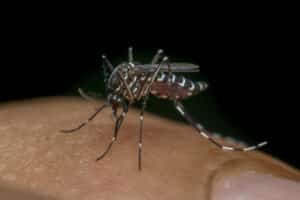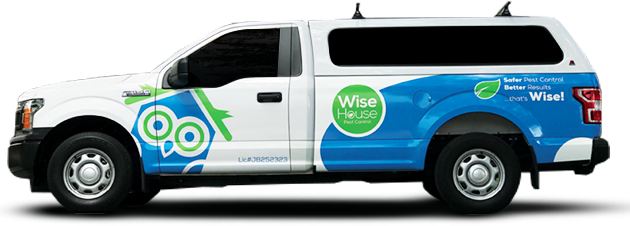Welcome to South Florida, a paradise for sun-seekers and, unfortunately, also a haven for mosquitoes. These tiny bloodsuckers are more than just an annoyance, each type of mosquito has its own unique habits and habitat preferences. From ruining backyard barbecues to lurking in the shadows, ready to attack unsuspecting homeowners, these pests can quickly turn a tranquil evening into an itchy nightmare. Let’s go over the 5 most common mosquito species buzzing around your backyard in Florida, so you can be prepared to fight back.

This mosquito species can cause several debilitating diseases, including Zika, dengue, and chikungunya. This mosquito’s ability to transmit such a wide range of viruses makes it a significant public health concern and risk in South Florida.
The Aedes aegypti mosquito is easily identifiable by its small size, dark coloration, and characteristic white markings on its legs, which resemble a lyre or harp. These mosquitoes are diurnal, meaning they are most active during the day, making them a persistent nuisance during outdoor activities.
Their breeding habits are particularly concerning, as they prefer to lay eggs in artificial containers around human habitation, such as flower pots, birdbaths, discarded tires, and even small puddles of water. The proximity to humans increases the risk of disease transmission and necessitates vigilant mosquito control measures.
The Asian tiger mosquito, a fairly relative newcomer to South Florida, has quickly established itself as an aggressive daytime biter and a potential carrier of various diseases, including dengue and chikungunya. This invasive species is easily recognizable by its bold black and white stripes, resembling a tiger’s pattern.
Unlike the Aedes aegypti, which primarily breeds in artificial containers, the Asian tiger mosquito is more adaptable and can breed in a wider range of habitats, including tree holes, rock pools, and even discarded plastic bags. This adaptability, coupled with its aggressive biting behavior, makes it a significant threat to public health in South Florida. The Asian tiger mosquito is not only a nuisance but can also transmit diseases, making it a prime target for mosquito control efforts in the region.
A quintessential backyard pest, the Southern house mosquito, or Culex quinquefasciatus, is pretty common to see in South Florida. Recognizable by its brown coloration and blunt abdomen tip, this species is primarily active during the evening and nighttime hours.
While not as visually distinctive as some other mosquito species, its persistent buzzing and itchy bites are a familiar nuisance to many local residents. The Southern house mosquito thrives in stagnant water sources such as ditches, ponds, and even neglected birdbaths. This makes it a potential transmitter of several different diseases, most notably the West Nile virus and various encephalitis viruses.
The Anopheles quadrimaculatus, often referred to as the common malaria mosquito, is identifiable by its dark brown coloration and four distinct dark spots on each wing. This species is active at dawn and dusk, exhibiting a crepuscular behavior pattern.
Unlike the container-breeding Aedes species, the Anopheles quadrimaculatus prefers to lay its eggs in natural freshwater habitats with abundant vegetation, such as marshes, swamps, and slow-moving streams. While malaria cases in the United States are rare, this species historically played a significant role in malaria transmission and continues to pose a potential risk in certain areas of South Florida.
The gallinipper, or Psorophora ciliata, is not your average mosquito. This formidable species is notably larger than most mosquitoes and possesses an aggressive nature. It is recognizable by its hairy legs and large size, making it a rather intimidating presence. Gallinippers are particularly active during the day, especially after heavy rainfall, as they breed in temporary floodwaters.
While not typically a vector for major diseases, their bites are exceptionally painful, often causing intense itching and localized swelling. Their voracious appetite and painful bites make them a considerable nuisance for outdoor activities in South Florida.
Mosquitoes Love Your Scent – It’s not just your sweet blood they’re after. Mosquitoes are attracted to the carbon dioxide you exhale, the lactic acid in your sweat, and even the bacteria on your skin. This concoction of scents creates an irresistible perfume for these tiny vampires.
Gallinippers – Florida is home to the gallinipper (Psorophora ciliata), one of the largest mosquitoes in the world. These behemoths can grow up to 20 times larger than a common mosquito and deliver an exceptionally painful bite.
Mosquitoes Can Fly Up to 1.5 Miles Per Hour – While they may seem like clumsy fliers, some mosquito species can reach speeds of up to 1.5 miles per hour, making them surprisingly efficient at finding their next meal.
Male Mosquitoes Don’t Bite – That’s right, only female mosquitoes bite. For them to grow into eggs, blood protein is necessary. Male mosquitoes, on the other hand, feed on nectar and other plant sugars.
Mosquitoes Can Lay Hundreds of Eggs at a Time – A single female mosquito can lay hundreds of eggs in her lifetime, and these eggs can hatch in as little as a few days. This rapid reproduction rate is one of the reasons why mosquito populations can explode so quickly in warm, humid environments like South Florida.
Mosquitoes prefer habitats with standing water for breeding, such as ponds, marshes, and containers with stagnant water.
Some mosquito species can travel several miles from their breeding sites.
Yes, mosquitoes can breed indoors if there are sources of standing water, such as in plant saucers or pet water bowls.
The lifespan of a mosquito ranges from a few weeks to several months, depending on species and environmental conditions.
Yes, even a small amount of standing water, like that in a bottle cap, can be enough for mosquitoes to breed.
Yes, plants like lavender, citronella, and marigolds can help repel mosquitoes.

Ready to send away pests without harming your pets? Getting started with Wise House Environmental Services is as easy as 1-2-3:
With Wise House Environmental Services, you get more than just effective pest control; you get peace of mind, knowing that your home is without pests and safer for your pets.
Our approach to pest control combines science with safety, offering you the kind of targeted, effective solutions that you won’t find with just any other pest control service. Our services have made a world of difference for homeowners, and we can do the same for you. Your pets will thank you for it!
We serve Port St. Lucie,Lake Worth, Boyton Beach, Palm Beachand the Treasure Coast.


© 2023 All Rights Reserved. | Sitemap